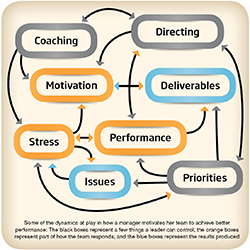
Why do most training programs fail to change behavior? One of the main reasons is most focus on the characteristics of leadership; they do not go below the surface, but, instead, focus on visible factors and address them by teaching concepts, tips, introspection and what great leaders do. But leadership, organizations and people are dynamic. Every factor needs to be understood from a systems perspective within the context of the organization.
Take a situation where morale is down, issues are up, and the team is falling behind on monthly objectives. What is the leader to do: Step in and tell the team specifically what needs to be done and how to do it (directing); mentor and teach the team to higher performance (coaching); or just increase the pressure on the team to get results (priorities)? What will be the short-term impacts on performance, stress and motivation? Are those acceptable? And what are the long-term effects?
Even well-intended actions can create undesirable results. Let’s say the leader decides to invest her energy on coaching others. As a result, motivation probably improves, which causes performance to improve. Consequently, many deliverables are accomplished; therefore, the team feels good and motivation further improves. But even with the most capable teams, things can go wrong and issues surface. As the issues increase, so does stress, which increases the number of issues and decreases motivation. When this happens, the leader begins to split her energy between resolving issues and increasing motivation through coaching. This makes sense conceptually, but when the team leader’s boss expresses concern that the team missed three of its five deliverables, she might decide it is time to take matters into her own hands and start directing others more diligently. This can cause motivation to plummet, as the team feels less confident of their ability to handle the job — creating the need for even more directing. They are also not getting the time and help needed to improve. They are just following orders and losing confidence, even though their performance might temporarily improve. If the leader does not understand the dynamics, these actions can cause performance levels to cycle between adequate and unacceptable, with increasing stress and eventual burnout.
With these powerful dynamics at work, even the best leadership tools, tips and tricks are impractical and inadequate. A more practical approach is to provide leaders with a framework that is adaptable, that helps surface the underlying dynamics and provides guidance on the best course of action. We call this framework the Core Thinking Practices. These practices are not meant to be followed in a particular order, nor are they meant to be applied as a procedure. Rather, these practices are meant to help leaders shed light on a situation by reframing it from different perspectives.
Seek to understand the big picture. Fixating on one thing may improve that one thing, but most likely it will create multiple new unintended issues. Leaders who establish a big-picture perspective not only reduce unintended issues, they improve collaboration among their teams because they will work together to understand the system instead of finding someone to blame.
Seek to understand the underlying behavior. The harder a leader pushes the system, the harder it will push back. Things tend to get worse before they get better and the cure is often worse than the disease. Those leaders who seek to understand these underlying system principles are better equipped to address their team’s needs in new and emerging situations.
Seek systemic change. If a leader tries to change something in the direct, obvious way, the system is going to treat those efforts like any other outside influence and do its best to neutralize them. Leaders should understand that genuine solutions require careful consideration of the possible short- and long-term outcomes to avoid the pitfalls that drain both the emotional and intellectual energy from their teams.
Seek to surface limiting beliefs. The root cause of failed efforts or unproductive meetings is often tied to the biases, flawed mental models, or fears of those involved. The more a leader surfaces her limiting beliefs — suspends her judgment — the more productive and supportive she will be at serving her teams and making the tough calls.
Seek to evolve a shared vision. An idea can gain momentum only if others believe in it; their hearts and minds need to be invested in the idea for it to take root and grow. Too often, leaders are moving too quickly and overlook the need for their team to evolve a vision together. When a leader seeks alternative perspectives and incorporates insights from others, only then do leaders realize the sustainable power of their team.
Michael Vaughan, author of The Thinking Effect, is a leading authority on serious games and business simulations known for his work in artificial intelligence. He is president and managing director of The Regis Company (regiscompany.com), a leadership consulting firm whose leadership programs are designed to fundamentally change the way leaders think.
















